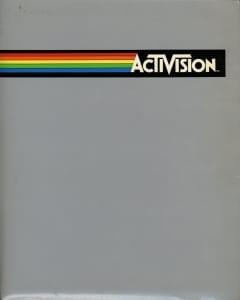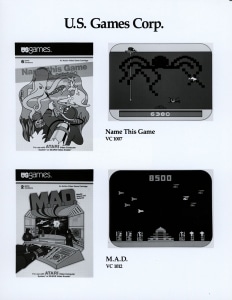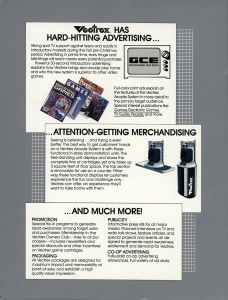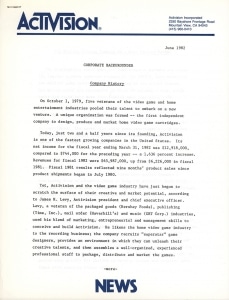 Each year since 1967 (and twice a year between 1978 and 1994), throngs of people crowd the floors of the Consumer Electronics Show (CES), eager to get a first look at the latest technological trends. In the early 1980s as video game developers such as Atari, Mattel, Imagic, General Consumer Electronics (GCE), Activision, and others vied for a share of the booming video game market, publicity teams assembled and handed out carefully curated folders filled with information about their companies and products. Companies used these “press kits,” packages of in-depth information given at press conferences, product launches, or special events, to help introduce themselves and their products to industry executives, retail buyers, and journalists who would report news from the event. Today, these press kits make invaluable sources for game historians for several reasons.
Each year since 1967 (and twice a year between 1978 and 1994), throngs of people crowd the floors of the Consumer Electronics Show (CES), eager to get a first look at the latest technological trends. In the early 1980s as video game developers such as Atari, Mattel, Imagic, General Consumer Electronics (GCE), Activision, and others vied for a share of the booming video game market, publicity teams assembled and handed out carefully curated folders filled with information about their companies and products. Companies used these “press kits,” packages of in-depth information given at press conferences, product launches, or special events, to help introduce themselves and their products to industry executives, retail buyers, and journalists who would report news from the event. Today, these press kits make invaluable sources for game historians for several reasons.
First, press kits contain an abundance of information in one package. A good press kit usually contains a variety of materials including a “backgrounder” (or document with official background information) on the company, event, or products; fact sheets; additional press releases; biographies; photos with captions; and reprints of relevant news articles. All these resources are conveniently bundled together in one place.
When bundled this way, press kits help document key information about company operations. What is a video game developer? How did the company get formed? What does the company do? A June 1982 Activision press kit included a corporate backgrounder that provided information on the firm’s history and its founding as the first independent home video game cartridge developer. The backgrounder also charted the company’s staggering rate of growth—a 1,636 percent increase in net income in fiscal year 1982—and its deep commitment to consumer involvement illustrated by the company’s game clubs (e.g.: “Activision Federation of Laser Blasters”) and the more than 6,000 fan letters they answered each week.
Press kits often include useful corporate fact sheets and biographical information about company leaders. For scholars studying the history of game companies, company fact sheets and executive biographies can provide vital information about corporate structure, leadership, and decision-making. A 1982 GCE press kit featured materials that identified the company’s headquarters, offices, board of directors, corporate officers (with professional biographies), counsel, bank, auditors, and partners. Together this information can help researchers better understand how companies and industries function.
Press kits also document products. At the International Center for the History of Electronic Games (ICHEG) at The Strong museum, scholars often examine original hardware, games, and peripherals, but they also need other visual and textual sources from that time showing what products looked like and describing how people played with them. For example, U.S. Games’ 1982 kit included a variety of press releases and promotional photographs of game packaging and gameplay for their line of Atari 2600 cartridge games.
 Press kits often summarize a company’s marketing and merchandising strategies. For example GCE’s 1982 press kit featured a full-color page outlining how the company would sell its Vectrex vector-based video game system by targeting teens and adults with “prime time,” “fringe” (just before or after prime time), and “early fringe” television commercials during the “pre-Christmas period.” They also promised to use print advertisements in publications such as Electronic Games, TV Guide, and People; in-store demonstration units and memorable packaging at the point of sale; and a club with free newsletters and incentives to engage consumers.
Press kits often summarize a company’s marketing and merchandising strategies. For example GCE’s 1982 press kit featured a full-color page outlining how the company would sell its Vectrex vector-based video game system by targeting teens and adults with “prime time,” “fringe” (just before or after prime time), and “early fringe” television commercials during the “pre-Christmas period.” They also promised to use print advertisements in publications such as Electronic Games, TV Guide, and People; in-store demonstration units and memorable packaging at the point of sale; and a club with free newsletters and incentives to engage consumers.
 For these reasons, video game press kits offer historians rich historical source material, but scholars also need to recognize the limitations of these sources. Created primarily to publicize a company and its products and to encourage media and retail buyer interest, press kits reflect how the companies viewed themselves and their products, and their place in the game industry. Press kits, then, are as much sources of “official” key facts and information as they are sources for understanding how companies shaped their own images.
For these reasons, video game press kits offer historians rich historical source material, but scholars also need to recognize the limitations of these sources. Created primarily to publicize a company and its products and to encourage media and retail buyer interest, press kits reflect how the companies viewed themselves and their products, and their place in the game industry. Press kits, then, are as much sources of “official” key facts and information as they are sources for understanding how companies shaped their own images.
If you have video game press kits you wish to donate, please contact the ICHEG team (jpdyson@museumofplay.org). We love to add new materials to our collection and ensure that these vital sources are available to scholars and preserved for future generations.
 Hours 10 a.m.–5 p.m. | Fri. & Sat. till 8 p.m.
Hours 10 a.m.–5 p.m. | Fri. & Sat. till 8 p.m.
